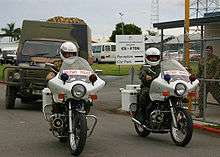Land Rover Perentie

The Land Rover Perentie[1] is a nickname for the Land Rover 110 produced by JRA Limited for the Australian Army, and part manufactured and assembled in Moorebank, New South Wales, during the 1980s and 1990s. There were two build contracts. The first was in 1988 and the second build quantity occurred in 1998. The Perentie was based on the Land Rover Defender 110, and was introduced in 1987 to replace the ageing fleet of Series 2A and 3 Land Rovers. The Land Rover Perenties were produced in 4 x 4 and 6 x 6 variants and powered by an Isuzu 3.9-litre four-cylinder 4BD1 diesel engine or 4BD1-T turbo (see List of Isuzu engines), and has proven itself both in Australia and on operations overseas, including in Somalia, Timor Leste, the Solomon Islands, Iraq and Afghanistan.[2]
The major differences between the Land Rover Perentie and British Land Rovers are the relocation of the spare wheel to a position under the rear of the load area, a galvanised chassis and the Isuzu engine. The original army contract called for a variety of unusual features including being able to sustain being hung from a helicopter by one corner without causing the chassis to distort. The 6 x 6 version has a wider cab and load sharing leaf-sprung rear axles. The 6 x 6 also has a turbocharger. The original order was for 2,500 4 x 4 and 400 6 x 6 vehicles between 1987 and 1990, while further vehicles were later added under Project Bushranger.
The name Perentie originates from Land Rover's successful tender to Project Perentie,[3] which was the official Australian Army trial to select new 1 and 2-tonne light vehicles. During the Project Perentie trials the Land Rover/Isuzu 110 and 6 x 6 variants were compared against the Jeep AM10, the Mercedes-Benz 300GD and the Unimog, while the Toyota Landcruiser was evaluated two years later. The origins of the name comes from the Perentie (Varanus giganteus) lizard species, which is the largest goanna lizard native to Australia.
As of February 2013 the Perenties are being disposed of, with the remaining in-service units being replaced by Mercedes-Benz G-Wagons under Project Land 121.[4][5]
Variants
4X4 Variants
- Truck, Utility, Lightweight, MC2 (Mobility Category 2) (1222 Vehicles)
- Truck, Utility, Lightweight, Winch, MC2 (314 Vehicles)
- Truck, Utility, Lightweight, FFR (Fitted For Radio), MC2 (964 Vehicles)
- Truck, Utility, Lightweight, FFR, Winch, MC2 (208 Vehicles)
- Truck, Panel, Lightweight, Survey, FFR, Winch, MC2 (35 Vehicles)
- Truck, Carryall, Lightweight, Senior Commander, FFR, Winch, MC2 (11 Vehicles)
- Truck, Carryall, Lightweight, Personnel Carrier, MC2 (38 Vehicles)
- Truck, Surveillance, Lightweight, Winch, MC2 (RFSV, Regional Forces Surveillance Vehicle) (231 Vehicles)
6X6 Variants

- Truck, Cargo, Light, MC2 (215 Vehicles)
- Truck, Cargo, Light, Winch, MC2 (32 Vehicles)
- Truck, Ambulance, 4 Litter, FFR, Winch, MC2 (94 Vehicles)
- Truck, General Maintenance, Light, Winch, MC2 (GMV) (181 Vehicles)
- Truck, Electronic Repair, Light, MC2 (ERV) (40 Vehicles) and Truck, Comsec Repair Workshop *Vehicle, Light, MC2 (12 Vehicles)
- Truck, Long Range Patrol, Light, Winch, MC2 (LRPV) (27 Vehicles)
- Truck, Air Defence, Light, FFR, Winch, MC2 (72 Vehicles)
- Truck, Crew Cab, Light, Winch, MC2 (26 Vehicles)
- Truck, Infantry Improvised Mobility Vehicle, MC2 (number unknown)
See also
References
- ↑ Comment on Perentie name by Mike Cecil Curator of vehicles, Australian War Memorial (Ret.) http://www.mapleleafup.net/forums/showpost.php?p=176252&postcount=22
- ↑ http://www.defence.gov.au/op/afghanistan/info/general.htm Australian Army general info on Afghanistan operations 2002 thru 2013
- ↑ http://remlr.com/perentie-project.htm Project Perentie information page REMLR
- ↑ http://www.defence.gov.au/dda/vehicles/index.htm
- ↑ http://www.defence.gov.au/dmo/lsd/land121/ Australian Defence Materiel Organisation procurement Project Land 121 Phase 3A Mercedes G-Wagen enters service
External links
- "Project Perentie". 4wd Online.